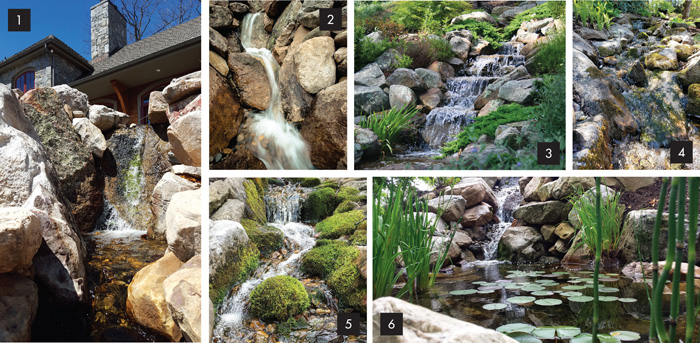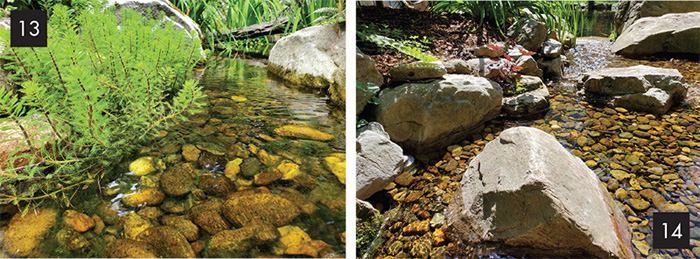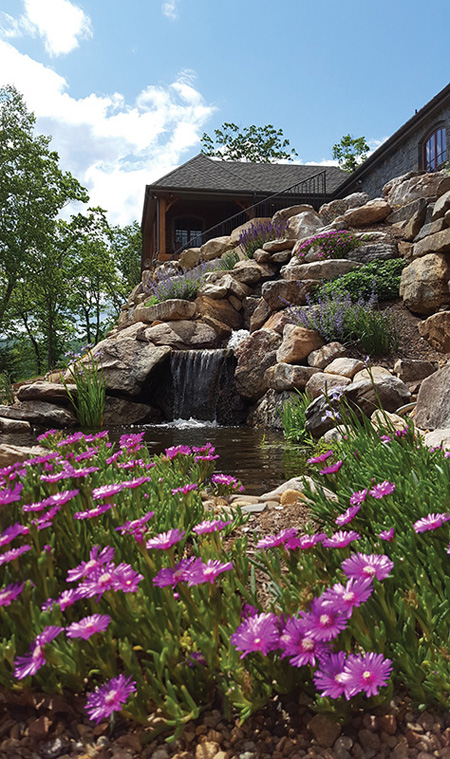 In its basic form, water is the basis of all living matter. When pure, it is an odorless, tasteless liquid that descends from clouds as rain to form streams, lakes, ponds and oceans, only to return again to the atmosphere. Earth’s water is always in movement, which we know as “the cycle of water.”
In its basic form, water is the basis of all living matter. When pure, it is an odorless, tasteless liquid that descends from clouds as rain to form streams, lakes, ponds and oceans, only to return again to the atmosphere. Earth’s water is always in movement, which we know as “the cycle of water.”
In reality, the cycle of water has no starting point. We as waterscape contractors focus our business on mimicking the part of the cycle where water is flowing on the ground. In pursuit of being better contractors, we are constantly trying to evaluate and play off what Mother Nature does on a daily basis when water is in motion. We all know water behavior and stream flow is constantly changing in nature. We are fortunate, though, to be able to construct systems that, for the most part, stay constant. The fact that we deal with minimal influencers and variables that change the behavior of our designs allows us to get quite creative with controlling how water moves throughout our systems.
‘Peak’ Perspective
My business is located in the Smoky Mountains of North Carolina, where elevation, rock and water are abundant. These resources have driven my business to focus heavily on designs that follow natural form and function. The mountains of western North Carolina have given me endless opportunities to study water’s behavior. The natural streams and waterfalls here are continually providing me with ideas and concepts to experiment with.
>> Related Content | The Vital Basics of Rock Watershaping
After studying these streams in the wild and constructing waterscapes over the last 20 years, I’ve come to realize that there are many different variables and combinations of variables that can greatly influence a design and its functionality. It’s important to weigh all these variables when designing a waterscape, or you could end up with a feature that doesn’t quite hit the mark. It’s important to think about elevation, proportion, flow rates, stone selection, stone placement, sound and even plant selection. When constructing a waterscape, you really have to focus on the design to create the best flow.
Elevation
Elevation can play a big role in flow design. Here in the Smokies, 95% of our builds have a serious grade change, with some slopes up to 45 degrees. The most important thing with a design that has significant grades is water containment. We will typically build deeper into the site to allow the water and splashing to remain within the system.
If you look at image #1, you will see that the system is dug deeper into the grade to contain the flow. A majority of these stones were 800 — 1,000 lbs. and set on a significant grade. We had to descend from a high elevation over a short distance, so we placed a large, thick boulder in a vertical position with a slight pitch backward. This allows a large volume of water to carry down the rock, as opposed to crashing down, which would create a large splash area. This method is great at containing water on large elevation changes.
In photo #2, we have a large volume of water again set into a deeper excavation. We channeled the water in a tighter flow, which allows the viewer to enjoy a higher flow design at a farther distance.
Sound
One of the more overlooked components of designs is the creation of sound. We’ve all been called out to service or repair systems that were designed by other contractors, and in the case of many of the ones I’ve visited, sound was the one major element that was overlooked. The system was either lacking in water flow, creating a peeing-statue sound, or it was so loud that after five minutes, you found it more annoying that enjoyable.
There are endless designs and tricks to creating a multitude of sound. This design in photo #3 was constructed with several cascades and a medium flow rate. This design can create higher-pitched tones, which are great for carrying sound at a longer distance. It also creates a great visual appeal.
When we have a project that doesn’t have an elevation change and we are trying to create a lot of sound, we will design a stream as seen in pictures #4 & #5. Here we used a medium flow rate with a large number of stones to impede the water flow. When you break up the flow, you create a mix of high and low tones that produce a great babbling-brook sound, which can encompass a larger area. I’ve found that this type of sound really intrigues people and can draw them in to explore. Kids really love to engage with these kinds of designs, as they are just fun to watch.
Stonework
Proper stone placement is key if you’re going for high-volume water while incorporating floating aquatic plants. This is especially challenging in a small pond. We have dealt with this a lot up here in the mountains, as we are limited on how big we can build our ponds.
One trick we use to keep the high flow rates from disturbing the water column too much is the strategic placement of stones. In photos #6 & #7, you can see a significant grade change with a high flow rate. Where the waterfall comes down into the pond, we restrict the width and channel the water. This helps reduce some of the disruption. The key to this effect, though, is the placement of a boulder below the water’s surface, just past where the water enters the pond. This location greatly reduced the turbidity created by the high-volume flow. You can see how well the waterlilies are doing so close to the waterfall.
The placement of stones in streams can also be important, and not just for aesthetics. When building on slopes, sometimes it’s hard to make a stream change direction or travel horizontally across the hill. Just having the stream come straight down the hill can come off as contrived. Some properly placed stones in a stream can break up the water’s path and create a better visual interest as seen in photo #8. This can also help reduce the velocity of the flow, which helps reduce splashing.
This same concept can be accomplished with the use of logs and driftwood (image #9). Stone placement can also impact the feature’s design, even when it’s at the bottom of a pond.
One of my favorite things that is often overlooked is what’s happening at the bottom. The lake in picture #10 and just about every large body of water there is a channel at the bottom that is always moving. Here in this liner pond on the side of a mountain, we created a stream appearance at the bottom. This is a great visual for ponds that are mostly viewed from above. This design concept gives you the sense that the system has been there a long time, but it also gives you a feeling that the pond is flowing in a certain direction. Design with stones is important below water as much as it is above water.
 Artistic Touch
Artistic Touch
While the stonework is certainly my favorite part of water-flow design, don’t count out the importance of incorporating plants, art and structures to help draw people in. Art can really transform a feature.
In photo #11, we placed a Buddha head right in the middle of a waterfall area for our client. The water peels around the head to create a perfect frame for the art. This setup breaks up the stream and adds a fun focal piece.
We also love using bridges and special-shaped stones to bring interest to a design. Incorporating aquatic plants in streams and ponds can greatly increase beauty and the natural behavior of water. It can be a challenge sometimes to incorporate aquatic plants into large waterfalls and high-flow designs. I really enjoy using them with stones in streams to influence the way water moves through a system. You can see in photo #12 how the creeping jenny has moved in around the stone that was positioned in this low-flow stream.
When you have large-volume flow and you want to slow it down, you can go wider and deeper, which will allow for more planting options. The same stream where we planted some parrot’s feather that has grown out into the current is shown in photo #13. The movement of plants in a stream bring a natural feel to system.
In photo #14, we can see Heuchera hug the side of the stream and irises planted farther downstream. The irises can take a higher flow rate than most and work great in areas where a stream flow picks up.
Design Considerations
Experimenting with all these variables that influence a system design really keeps me inspired. I enjoy playing around with new concepts and ideas. We learn from trial and error, and some ideas don’t always work out. Mother Nature is hard to mimic in a closed system sometimes, but we do our best to follow her patterns.
I would also say that what we do here in the mountains may not be exactly how someone would or could build in the flatlands. That’s another great thing about this industry — we all have different variables to work with, and we all have different approaches to how our systems flow.
I’ve been involved in many builds across the country that have included countless numbers of contractors over the years. Working with other professionals has allowed me to absorb so many tips and tricks when it comes to design. This has really pushed me along and inspired me to try different ways to control and play with water. I always tell my crew to not be afraid to try something new.
“Water is never constant, so I believe design shouldn’t be, either.” I have always carried this quote around with me in my head since I dug my first pond at eight years old. I hope you enjoy it has much as I do!




